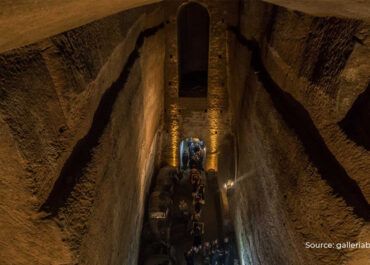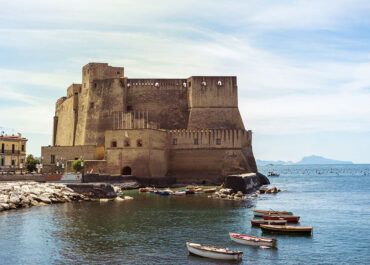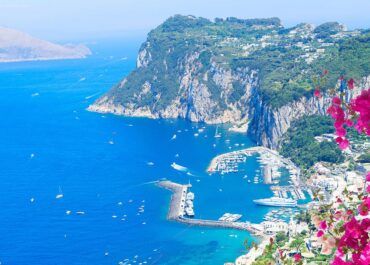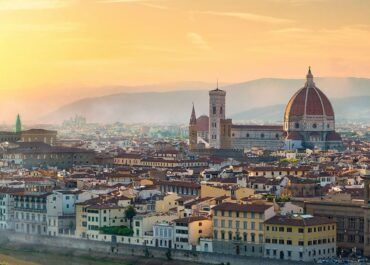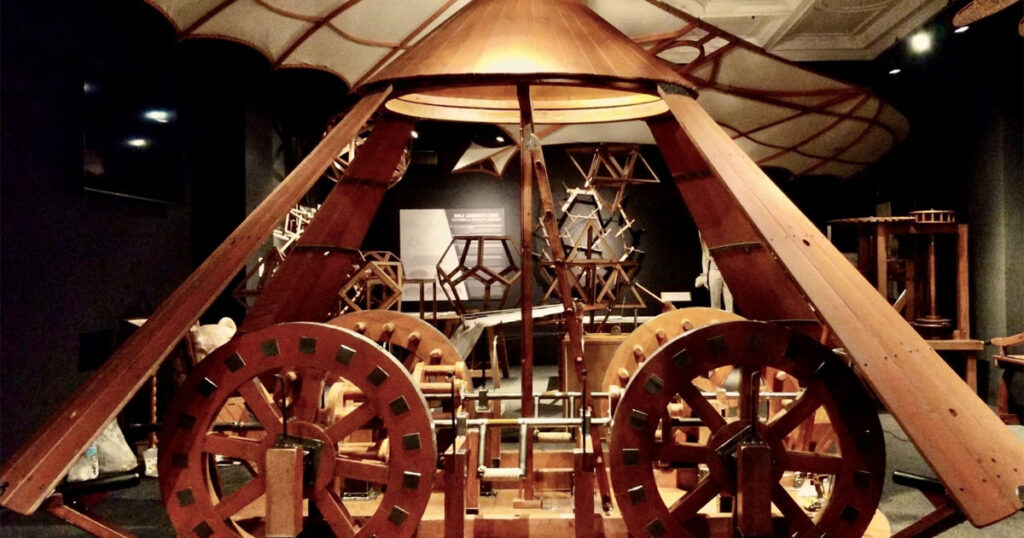Are you looking for the ultimate guide to Capri? Look no further! We’ve rounded up 33 epic things to do on this beautiful Italian island.
First up, take a stroll through the charming isle of Capri. The narrow streets are lined with boutique shops and cafes, perfect for an afternoon of people-watching.
Next, head to the famous Blue Grotto. This stunning sea cave is only accessible by boat and is known for its vibrant blue waters.
For adventure-seekers, hike up Mount Solaro, the highest point on the island. The panoramic views from the top are breathtaking.
If you’re looking for relaxation, head to Capri’s many beaches. Marina Piccola and Faraglioni are two popular options.
Capri also has several stunning gardens, including Villa San Michele and Giardini di Augusto. Both offer beautiful views of the island’s landscape.
Foodies will love exploring Capri’s culinary scene. Be sure to try local specialties like Caprese salad and limoncello liqueur made from locally grown lemons.
Every trip to Capri would be complete with a visit to the iconic Piazzetta Square. This bustling hub is perfect for people-watching and enjoying gelato or espresso at one of the many outdoor cafes.
Overall, this picturesque island paradise has plenty of things to do. Capri has something for everyone, whether looking for adventure or relaxation.
An Overview of Capri
Capri, oh Capri. This small island off the coast of Italy is a true gem in the Mediterranean Sea. With its crystal clear waters, stunning cliffs, and charming town center, it’s no wonder why Capri is a popular vacation destination.
The island is only about 4 square miles, so exploring on foot or by scooter is easy. One of the must-visit spots is the Blue Grotto, a sea cave that glows with an ethereal blue light. Visitors can take a boat tour to see this natural wonder up close.
Another popular attraction is the Piazzetta, a bustling square filled with outdoor cafes and shops selling local handicrafts. From here, visitors can take a funicular to Anacapri to enjoy breathtaking island views from Mount Solaro.
For those looking for some relaxation, there are plenty of beaches. Marina Piccola is one of the most popular beaches on the island and offers stunning views of the Faraglioni rock formations.
Capri also has a rich history dating back to ancient times. The ruins of Villa Jovis, once home to Emperor Tiberius, are a must-visit site for history buffs.
In terms of food, Capri has an abundance of seafood thanks to its location in the Mediterranean Sea. Visitors should try local specialties, such as spaghetti alle vongole (with clams) or fresh grilled fish.
Capri has something for everyone – from stunning natural beauty to rich history and delicious cuisine. So it’s no wonder why this small island has become such a popular vacation destination.
A Brief Geography Lesson of Capri
Welcome to the beautiful island of Capri! This small but stunning island sits in the Tyrrhenian Sea, off the coast of Italy’s Campania region. Breathtaking scenery, crystal-clear waters, and charming villages characterize Capri.
The island is 4 miles long and 2 miles wide but boasts a rugged landscape with cliffs and rocky coves. The highest point on Capri is Mount Solaro, which stands at 1,932 feet above sea level. From here, visitors can enjoy panoramic views of the island and the surrounding sea.
One of the most famous attractions on Capri is the Blue Grotto (Grotta Azzurra). This natural sea cave is renowned for its brilliant blue waters, illuminated by sunlight that enters through an underwater opening. Visitors can take a small boat into the cave to see this stunning sight up close.
Several charming towns and villages also call Capri home. The main town on the island, Capri Town (also known as La Piazzetta), fills with designer shops, cafes, and restaurants. Another popular spot, Anacapri, sits high above Capri Town as a miniature village. Here, you can wander through narrow streets with colorful homes and quaint shops.
Plenty of hiking trails on Capri offer stunning views of the island and its surroundings if you’re looking for outdoor adventure. One popular route is the Pizzolungo Trail, which takes visitors along the island’s western coast.
Overall, Capri is a must-see destination for anyone traveling to Italy. It’s stunning natural beauty and charming villages make it a truly unique place to visit. So pack your bags and prepare for an unforgettable experience on this beautiful island!
Best Time to Visit Capri
If you plan to visit the beautiful island of Capri, you might wonder when the best time to go is. Well, it all depends on your preferences and what you want to do on the island.
The peak season in Capri is from June to August, which means more crowds and higher prices. However, this is also when the weather is at its best, with sunny days and warm temperatures perfect for swimming and sunbathing. So, if you’re looking for a lively atmosphere with plenty of events and activities, summer is the best time to visit Capri.
On the other hand, if you prefer a quieter and more affordable vacation, consider going in the shoulder season (April-May or September-October). The weather is still pleasant during these months, but there are fewer tourists and lower prices. Moreover, you can enjoy all Capri offers without feeling overcrowded or rushed.
If you’re interested in hiking and outdoor activities, autumn (October-November) might be the best time. The temperatures are more relaxed, making exploring the island’s scenic trails easier without getting too hot. Plus, you’ll see the beautiful fall foliage in all its glory.
Finally, if you’re on a budget or want to avoid crowds altogether, then winter (December-March) might be your best bet. Although it can get chilly and rainy this time of year, you’ll have the island almost entirely to yourself. Plus, many hotels and restaurants offer discounts during the off-season.
In conclusion, there’s no one-size-fits-all answer regarding the best time to visit Capri. It all depends on your preferences and priorities. Capri has something for everyone, whether looking for a lively summer vacation or a peaceful winter retreat.
How Much Time Do You Need on Capri?
Hey there, fellow travelers! So you’re planning a trip to Capri and wondering how much time you need to experience this beautiful island fully? Well, look no further because I’ve got you covered.
First, talk about what you want to see and do on Capri. One day is enough to quickly stroll through the town center and visit the famous Piazzetta. But if you’re going to explore more of the island and all its attractions, I recommend staying for at least 2-3 days.
One of the must-see attractions on Capri is the Blue Grotto, a stunning sea cave with crystal clear blue water. But first, you’ll need to take a boat tour, which takes about an hour or two, depending on where you depart. And once you arrive, you’ll want to take in the beauty and snap some photos.
Another popular activity on Capri is hiking. The island has several trails that offer breathtaking views of the coastline and surrounding areas. If hiking is your thing, then stay for at least 3-4 days so you have enough time to explore all the trails.
Of course, only a trip to Capri would be complete with indulging in some delicious Italian cuisine. From fresh seafood to homemade pasta, plenty of restaurants and cafes on the island serve mouth-watering dishes. So leave sometime in your itinerary for a leisurely meal or two.
In conclusion, while it’s possible to see some of Capri’s main attractions in just one day, I recommend staying for at least 2-3 days to experience all these beautiful islands fully. Happy travels!
How to Get to Capri
So you’ve decided to visit the beautiful island of Capri! Congratulations, you’re in for a treat. But now comes the question: how do you get there? Don’t worry; we’ve got you covered with all the information you need to make your way to this Italian paradise.
The first step is to get to Naples, which can be done by plane, train, or bus, depending on where you’re coming from. Once in Naples, head to the Molo Beverello port, where ferries regularly depart for Capri. Depending on your preference and budget, you can take a high-speed hydrofoil or a slower ferry.
For an added touch of luxury to your journey, consider opting for a private boat transfer from Naples or Sorrento to Capri. This choice offers stunning coastline views and ensures a stylish arrival.
Another option is to take a helicopter transfer from Naples directly to Capri. While this method of transportation is the fastest and most glamorous way to reach your destination, it does come at a significant cost.
Several transportation options, including buses, taxis, and funiculars, are available once you arrive in Capri. If you’re feeling up for it, plenty of hiking trails will lead you through some of the island’s most beautiful scenery.
No matter how you choose to get there, we guarantee that the stunning beauty of Capri will make it all worth it. So pack your bags and start planning your trip today!
From Sorrento
If you’re visiting Sorrento, take the chance to take a day trip to Capri. This beautiful island is just a short boat ride away and offers stunning views, delicious food, and plenty of things to do.
First things first – how do you get to Capri from Sorrento? You can take a ferry or hydrofoil from the Marina Piccola or Marina Grande. The journey takes around 20-30 minutes, and the views are amazing. Once you arrive, there are plenty of options for exploring the island.
One of the most popular things in Capri is taking a boat tour around the island. First, you’ll see the famous Blue Grotto and other beautiful caves and rock formations. Then, if you’re feeling adventurous, you can swim in the crystal-clear waters.
Plenty of walking trails offer amazing island views if you prefer to stay on land. One popular option is the Pizzolungo trail, which takes you along the coast and through beautiful gardens. Another option is to take a chairlift to Monte Solaro for panoramic views of Capri and beyond.
Of course, only a visit to Capri would be complete with trying some local food. The island is famous for its limoncello, so try some while you’re there. You’ll also find plenty of seafood dishes and traditional Italian favorites like pizza and pasta.
Overall, a day trip to Capri from Sorrento is worth it. Whether you want to relax on a boat tour or explore the island’s many walking trails, there’s something for everyone on this beautiful island.
From Naples
Hey there, fellow travelers! If you’re heading to Naples, you must make a day trip to the stunning island of Capri. Trust me; it’s worth it.
To get to Capri from Naples, take a ferry or hydrofoil from the port of Mergellina or Beverello. The journey takes about an hour, and the views of the Bay of Naples are breathtaking.
Once you arrive in Capri, there are many things to do and see. One of the most popular attractions is the Blue Grotto, a magical sea cave that glows blue from the sunlight reflecting the water. You can take a boat tour to see it up close.
Another must-visit spot is the Gardens of Augustus, which offers stunning panoramic views of the island and its turquoise waters. You can also take a chairlift to Mount Solaro for even better ideas.
Head to the Piazzetta, Capri’s main square, for those looking for shopping and people-watching. It’s filled with designer shops and trendy cafes where you can relax and soak up the atmosphere.
Of course, a trip to Capri would only be complete with trying some of their famous limoncello liqueur. It’s made from locally grown lemons and is deliciously refreshing.
Overall, Capri is a must-visit destination for anyone traveling to Naples. It’s a paradise island with stunning natural beauty and plenty of activities and sights to entertain you all day. So make sure to take advantage of this gem!
From Positano
Hey there, fellow travelers! Are you planning a trip to Capri? Well, let me tell you about a beautiful way to get there – from Positano.
First things first, take a ferry from Positano’s port. It’s a scenic 30-minute ride that will have you in awe of the stunning views of the Amalfi Coast. Make sure to bring your camera!
Once you arrive in Capri, walk around the charming town center and visit the Piazzetta, the island’s heart. Then, grab a bite to eat at one of the local restaurants or cafes and enjoy some people-watching.
Next, take a boat tour around the island and see Capri’s famous grottos, including the Blue Grotto with its bright blue waters. The boat tour is an absolute must-do when in Capri.
If you’re feeling adventurous, hike up to Mount Solaro, the highest point on the island. The views from the top are breathtaking and well worth the effort.
Capri is also known for its luxurious shopping options. So if you want to splurge, head to Via Camerelle or Via Vittorio Emanuele for high-end designer stores.
Finally, end your day by watching the sunset from Punta Tragara. It’s a stunning sight that will leave you speechless.
In conclusion, getting to Capri from Positano is an experience that will set the tone for an unforgettable trip. With its natural beauty and luxurious offerings, Capri is a destination to notice. Happy travels!
By Bus
Hey there, fellow travelers! If you plan a trip to Capri and want to save money while exploring the island, taking a bus is your best bet. Not only is it affordable, but it’s also a great way to mingle with the locals and experience the island like a true Caprese.
First things first, you need to know that there are two types of buses on the island: the orange buses (called “Capri Bus”) and the blue buses (called “Anacapri Bus”). The orange buses run between Marina Grande (the main port) and Capri town, while the blue buses run between Capri town and Anacapri, located on the higher part of the island.
The tickets for both types of buses can be purchased at authorized kiosks or onboard (although buying them in advance is always recommended). A single-ride ticket costs around €2 ($2.30), while a daily ticket (valid for unlimited rides) costs around €8 ($9.20). Remember that cash is preferred, as not all kiosks accept credit cards.
Now, let’s talk about the routes. The orange bus route takes you from Marina Grande to Capri town via a winding road with stunning sea views and cliffs. The journey takes around 15 minutes and drops you off near Piazzetta (the main square), surrounded by shops, restaurants, and cafes.
The blue bus route takes you from Capri town to Anacapri via an even more scenic road that passes through lush gardens and historic villas. The journey takes around 25 minutes and drops you off near Piazza della Pace, where you can admire the breathtaking views from Mount Solaro or visit Villa San Michele (a museum dedicated to the Swedish physician Axel Munthe).
Taking a bus in Capri is a fun and practical way to get around the island while enjoying its natural beauty. So, hop on board and enjoy the ride!
By Taxi
Hey there, if you’re planning a trip to Capri, you’ll want to ensure you know how to get around. One of the most popular ways to get around the island is by taxi.
First, remember that taxis on Capri differ from what you might be used to. The island has a limited number of taxis, which are more expensive than you might find in other parts of Italy. However, they’re also very convenient and can save time and hassle.
To hail a taxi on Capri, look for one of the taxi stands located around the island. You can also ask your hotel or restaurant to call one for you. Remember that finding a taxi immediately available during peak tourist season can take time.
Once you’re in the taxi, communicate clearly with your driver about where you want to go. Some parts of the island can be tricky to navigate, so it’s always best to double-check that your driver knows exactly where you want to go.
If you plan to take a more extended trip around the island or want to see some sights outside of Capri town, consider negotiating a flat rate with your driver instead of relying on the meter. This can help save you money in the long run.
In general, taxis serve as an excellent means of transportation around Capri, especially if you’re in a hurry or need extra time. However, remember that they might cost more than other transportation options on the island.
By Scooter
Are you planning a trip to Capri and wondering how to get around the island? Look no further than a scooter rental!
Exploring Capri by scooter is convenient and allows you to take in this beautiful island’s sights and sounds at your own pace. From the stunning views at Punta Carena lighthouse to the famous Blue Grotto, there’s no shortage of breathtaking scenery.
Renting a scooter on Capri is easy – several rental shops are available on the island. Prices vary depending on the time of year and length of rental but expect to pay around €40-€50 per day. You’ll need a valid driver’s license and passport or ID to rent a scooter.
Once you have your scooter, it’s time to hit the road! One of the most popular routes is the winding road up to Anacapri, where you can enjoy panoramic views of the island. First, stop at Villa San Michele, a beautiful villa-turned-museum Swedish physician Axel Munthe once owned.
Another must-visit spot is Marina Piccola, a picturesque beach with crystal-clear waters. From there, head over to the charming town of Capri and explore its narrow streets and designer shops.
Be sure to also take advantage of your scooter’s agility by exploring some of the island’s hidden gems, such as the secluded beach at Bagni di Tiberio or the tranquil gardens of Augustus.
Overall, renting a scooter is an excellent way to experience all Capri offers. However, remember to drive safely, wear a helmet, and place your camera!
By Boat
To experience the true beauty of Capri, consider exploring by boat. Whether you seek a relaxing day on the water or an adventure-packed excursion, exploring the island’s stunning coastline from the sea offers the best experience.
One of the most popular boat tours in Capri is the tour around the island, which takes you past some of the most iconic landmarks and natural wonders. You’ll see the famous Faraglioni rock formations up close, glide past the Blue Grotto, and witness stunning views of Marina Piccola and Marina Grande.
Private boat tours are also available for those seeking a more intimate experience. These tours can be customized to your preferences and needs, allowing you to create your itinerary and explore hidden coves and beaches inaccessible by land.
If you’re feeling adventurous, try a snorkeling or diving tour. The crystal-clear waters surrounding Capri are home to various marine life, including colorful fish and ancient Roman ruins. With a knowledgeable guide leading the way, you’ll have an unforgettable underwater experience.
No matter which type of boat tour you choose, be sure to wear comfortable clothing and bring sunscreen and plenty of water. And don’t forget your camera – there will be plenty of photo opportunities along the way!
You should notice the experience of exploring Capri by boat. Its stunning coastline, crystal-clear waters, and iconic landmarks make it easy to see why this island has been a favorite among travelers for centuries. So sit back, relax, and let the beauty of Capri unfold before your eyes.
Getting Around Capri
If you’re planning a trip to Capri, one of the most important things you’ll need to know is how to get around. Thankfully, this gorgeous island is relatively small and easy to navigate, with plenty of transportation options.
Taking a boat tour ranks among the most favored methods of exploring Capri. It offers a unique island perspective and allows you to appreciate the breathtaking coastal views. Numerous companies provide boat tours, with options varying from small group tours to private charters. For the more adventurous, there’s the option to rent your boat and discover the island at your leisure.
Another popular option for getting around Capri is taking the funicular up to the town of Capri. This cable car takes you from Marina Grande to the Piazzetta in just a few minutes, offering breathtaking views. Once in town, you can explore on foot or take a taxi or bus to other parts of the island.
If you want something more active, renting a scooter or bike is a great option. This provides the opportunity to discover Capri at your leisure and access areas that might be challenging to reach using other modes of transportation.
Just be aware that some of the roads on the island can be pretty narrow and winding, so it’s essential to be cautious and wear protective gear.
Finally, suppose you’re staying in one of Capri’s many luxury hotels or villas. In that case, they might offer transportation services, including private shuttles or helicopter transfers from Naples or Rome.
No matter how you choose to get around Capri, there’s no doubt that this beautiful island will leave you breathless at every turn. So sit back, relax, and enjoy all that this stunning destination has to offer!
The Funicular
If you’re planning a trip to Capri, one thing you have to experience is the funicular. This little cable car takes you up to the town of Capri from the Marina Grande, and it’s an experience you will remember.
The funicular offers a quick and easy way to ascend the steep hillside separating the port from the town. It’s a modern cable car system that has operated since 1907 and carries some history. The ride lasts only a few minutes, treating you to breathtaking island views.
Once you arrive in Capri, you’ll find yourself in the heart of the town. There are plenty of restaurants and shops to explore, and if you’re feeling adventurous, you can even hike up to the top of Mount Solaro for even more stunning views.
But before you do anything else, take a moment to appreciate the funicular. It’s a true feat of engineering and an essential part of Capri’s history and culture. So hop on board, sit back, and enjoy the ride!
The Chairlift
So you’re on the beautiful island of Capri, taking in all the sights and soaking up the sun. But have you taken a ride on the chairlift yet? If not, you’re missing out on one of the island’s most breathtaking experiences.
The chairlift takes you to the highest point on Capri, Mount Solaro, providing 360-degree views of the island and beyond. As you ascend higher and higher, you’ll see the sparkling blue waters of the Mediterranean, colorful villas dotting the hillsides, and even glimpses of neighboring islands.
The ride is peaceful and serene, with the only sounds of birds chirping and gentle breezes rustling through the trees. It’s a perfect escape from the hustle and bustle of daily life and a chance to appreciate nature’s beauty truly.
Once you reach the top, there are plenty of opportunities for exploration. For example, stroll along one of the many scenic paths or enjoy a picnic with stunning panoramic views.
So take advantage of this unforgettable experience during your visit to Capri. Instead, hop on that chairlift and let yourself be transported to new heights – figuratively and literally!
Tours of Capri
Yacht Charter and The Ganesh schooner Amalfi Coast is a wish come true. Choose it for your exclusive excursions and your special events. As children, we all dreamed of venturing out to discover the treasures of the sea, and who knows how many times we asked ourselves: what is the land like seen from the sea? The Mediterranean is a sea full of beauty, and we will take you to discover its rare pearls, which makes it even more exclusive and exciting to explore.
During your tour of Capri, you will have the opportunity to see some of the most stunning sights in the world. For instance, the Blue Grotto is a natural sea cave where the water glows a bright blue due to sunlight reflecting off the limestone walls. It’s a must-visit destination during your yacht tour of Capri.
Another popular spot on the island is the Faraglioni Rocks. These towering rock formations are a sight from both land and sea. You can get up close and personal with them by taking a boat ride around them or even diving into the crystal-clear waters beneath them.
If you’re interested in history, you must visit Villa Jovis. Emperor Tiberius built this ancient Roman palace over 2,000 years ago, offering stunning views of the island and surrounding sea.
Capri also has several charming villages that are worth exploring. Anacapri is a village known for its quaint streets, traditional architecture, and artisanal shops selling locally made products.
In conclusion, Capri is a breathtakingly beautiful destination that should be on everyone’s bucket list. And what better way to experience it than on an exclusive yacht tour? Book your trip today with Yacht Charter and The Ganesh schooner Amalfi Coast and make your dream of discovering the sea’s treasures come true!

